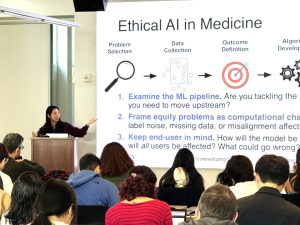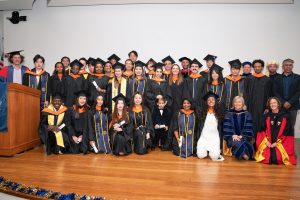The International Labour Organization estimates that there are 40.3 million victims of human trafficking globally. With the rapid adoption of social media platforms, human traffickers have the potential to target more vulnerable children. Yet artificial intelligence and machine learning also have the potential to thwart more predators and protect potential victims.
On April 26, the Anti-Trafficking Coalition at Berkeley, a Blum Center IdeaLab, gathered researchers and advocates from academia, industry, and the nonprofit sector to discuss how AI can help prevent child exploitation and combat human trafficking. The panelists included: Bob Rogers, expert in residence for AI at the UCSF Center for Digital Health Innovation; Lisa Thee, vice president of Bark.us, a child monitoring app; and Roger Martin, former Chief IP Strategist of Qualcomm and co-founder and CEO of the charity platform Enduragive.
Martin explained that preventing initial online communications between vulnerable children and suspected traffickers is a significant intervention. “Since 2015, the number one recruiting tactic into the sex trade happens online,” he said. “But there was a huge gap in using technology in prevention.” Predators were deciding whom to approach by looking at public profiles online and gauging vulnerability. If these vulnerabilities were modeled, Martin said, machine learning could be coded to detect which children were most likely to be approached.
Once a child goes missing, time is of the essence. In 2016, the National Center for Missing and Exploited Children employed 25 analysts receiving and disbursing about 8 million reports to law enforcement. Cases determined as “urgent” were automatically dispersed to a government agency, while others went to a 30 day backlog. Machine learning was introduced as a key part of the pipeline in 2017, automating the IP addresses and cell phone information of victims and predators. Since then, case backlog is down to 24 hours, and the time saved has allowed analysts to focus more deeply on specific cases.
When creating data sets to be fed to algorithms to prevent human trafficking, concerns about diversity and inclusion are life and death issues. As Thee of Bark.us explained, “Traditional facial recognition tools are good at identifying those who are white, adult, and male—which is almost the opposite of human trafficking victims. Pairing the grainy pictures of missing children with actual faces was our initial challenge.”
Finding technology companies to partner with the panelists’ initiatives presented significant challenges. “Storytelling has significant power,” Rogers said. “Press about how Intel can use its AI technology to save lives is powerful. But you have to be comfortable with rejection. Funding is always going to be a issue here—You have to be ready for a marathon and not a sprint.”
The panelists underscored that AI and machine learning are proving to be extremely helpful tools for this important human rights work. They also noted that the potential for student involvement is great, as this generation of university students are increasingly fluent in computer science, which can be put toward protecting vulnerable children around the world.
“Young people growing up online are in the midst of one of the largest social experiments in history,” said Thee. “This is labor intensive work, but in many ways you can work to save yourselves and your peers.”
—Veena Narashiman ’2020





